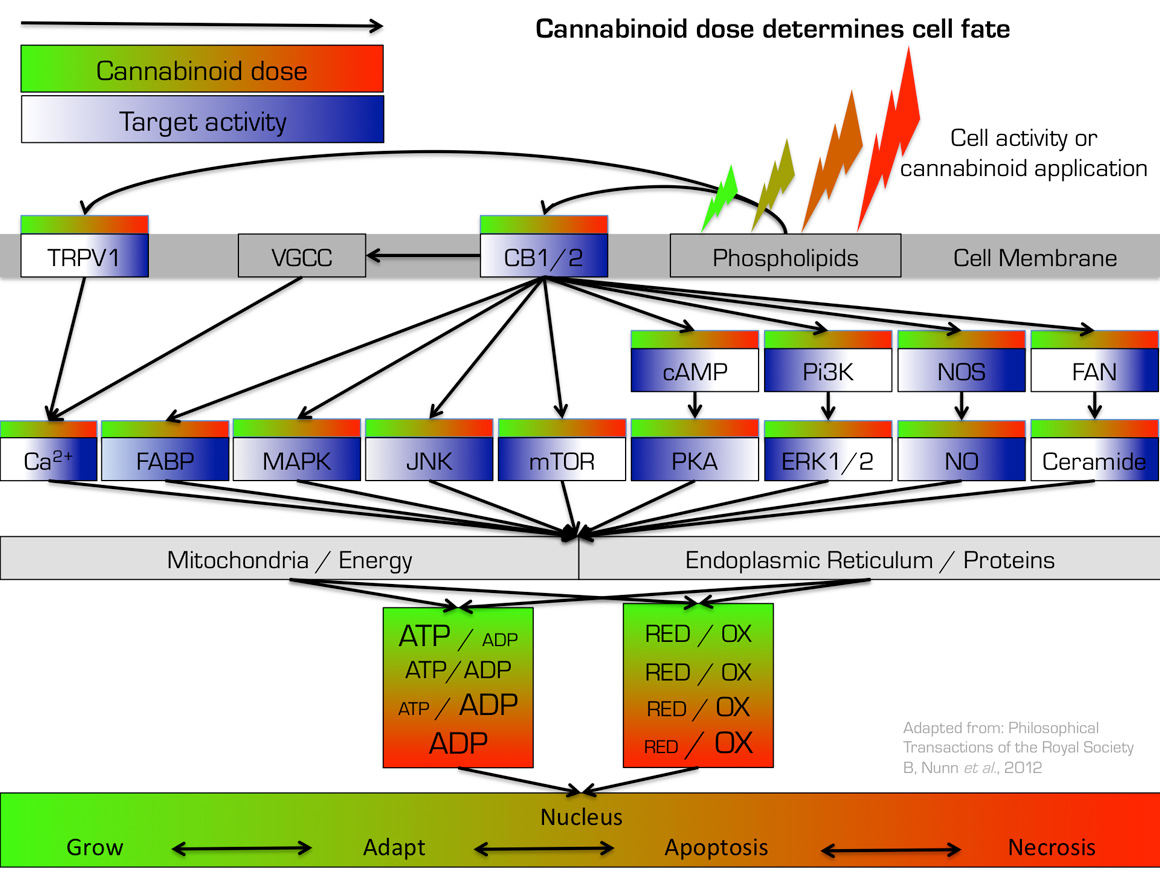To date, a total of 26 plant cannabinoids and 12 endocannabinoids have been described that have an effect on any of 40 different receptors in our body. This list is certain to grow in the future and already offers hundreds or thousands of potential cannabinoid-receptor interactions, and thus of potential (therapeutic) effects. The vast majority of these interactions are modulatory in nature, follow a bell-shaped activation curve and have a high degree of cooperativity/are co-dependent on other processes. This has three important implications:
- cannabinoid-controlled processes are hardly ever binary or ‘on-off’ but rather graded and subtle.
- Finding the right dose is crucial and under- or overdosing can exert unwanted or even opposite effects.
- Rather than looking at one cannabinoid or receptor, any physiological or therapeutic effect is more likely produced by a specific cocktail of cannabinoids and receptors and their web of interactions.
Without going deeper into the specific molecular function of cannabinoids, the endocannabinoid system generally functions to preserve biochemical balance in your body by controlling several of the most crucial feedback mechanisms in your body. The endocannabinoid system decides whether or not a cell divides, and as such is involved in cancer on the one hand and degenerative diseases on the other. endocannabinoids determine how much energy is available and how it is diverted. This ties in with cancer and metabolic disorders such as anorexia or obesity. endocannabinoids keep tight control of brain activity, thus shielding it from hyperactivity/seizures and other neurological disorders such as Migraine, depression and anxiety. Finally, endocannabinoids regulate self-recognition and thereby protect the body from self-degradation/auto-immune disease such as irritable bowel syndrome or Multiple Sclerosis.
Our goal is to map every component of the cannabinoid system, their function in normal physiology and their therapeutic potential. Via our website, we will inform the public of current scientific advancements and our ongoing research. We will formulate our products according to the latest clinical and pre-clinical data and tailored to specific uses or diseases.

- Cell activity or other relevant stimuli determine the amount of endocannabinoids that are released from the plasma membrane surrounding the cell.
- cannabinoids bind their receptors in the plasma membrane. In this example CB1, CB2 and TRPV1 activity determine cell fate through their respective downstream pathways. With 40 cannabinoid receptors discovered today and dozens of known endogenous (produced by the body) and exogenous (environmental) cannabinoids, the potential for fine-tuning is virtually limitless.
- Note that increasing cannabinoid dose affects different pathways in opposite directions; for instance Pi3K activity decreases while NOS activity increases with increasing cannabinoid dose.
- Downstream elements reach the cell’s power plant (mitochondria) and protein factory (endoplasmic reticulum) where they help determine the cell’s energy level (determined by the ATP over ADP ratio) and REDOX state (determined by the ratio of reducing and oxidizing agents in the cell).
- The cellular energy level and REDOX state instruct the nucleus how to respond to the current cannabinoid level
- Typically, a low cannabinoid dose tells the cell all is good and it can continue to grow.
- Increasing cannabinoid levels tell the cell something has changed and instruct it to adapt (biochemistry, physiology, shape, etc.).
- Even higher cannabinoid levels tell the cell it can no longer maintain it’s function or structural integrity and it instructs the cell to self-destruct (apoptosis).
- Extreme cannabinoid levels tell surrounding cells that their neighbor cell is under so much stress that it cannot even self-destruct and instructs them/the immune system to clear the affected cell (necrosis).
- This is how high doses of THC can instruct cancer cells to self-destruct and the immune system to battle the cancer.
- Other diseases, such as Alzheimer’s, are characterized by excessive cell loss though apoptosis and necrosis and would benefit from an entirely different cocktail of cannabinoids to push them back into adaptation or even growing.